It would seem that there is nothing difficult in caring for strawberries. However, even this unpretentious plant requires regular spraying both as prevention and for combating diseases and pests. Only with proper care, strawberry bushes will reward you with their tasty and fragrant berries. So, what to spray strawberries?
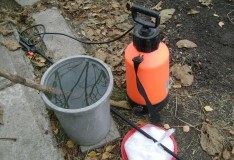
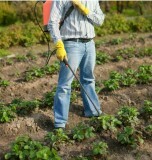
Gray or black rot on strawberries
Gray rot on strawberry berries is a fungal disease that occurs fairly quickly in wet weather, if not enough to care for strawberry bushes. Rot rotates rapidly, destroying the crop, so it is necessary to start fighting with it without the slightest delay.
- First of all, you need to carefully inspect all the bushes and remove each damaged berry. Since this rot has a fungal origin, it very quickly shifts the spores from berries to berries, spreading the disease. During picking berries do not touch the healthy bushes, since you can transfer the infection to them through your hands.
- Next, it is necessary to proceed directly to the spraying procedure. Ideally suited in this case is a solution of copper chloride. To cook it you need at the rate of 1 tablespoon of substance per 1 bucket of water. To process 1 square meter of the plot, you need about 1 liter of finished material.
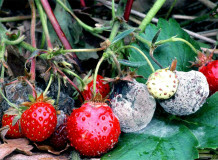 gray rot
gray rot 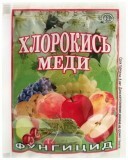 1 tbsp.spoon for 1 bucket of water
1 tbsp.spoon for 1 bucket of water
- After the last harvest is collected, you need to again process the plot. However, in this case, you should put 2 tablespoons of copper chloride per 1 bucket of water, and add a little liquid soap to this solution.
- In addition, if desired, you can process the site after harvesting 1% solution of the Bordeaux mixture.
Black rot is very similar to sulfur, however it has a distinctive bright black color and affects large areas of the garden. The treatment of beds for black rot is identical to the treatment described above using copper chloride. In addition, with this disease, the beds should be fertilized with a solution of manganese. For its preparation, 2 grams of potassium permanganate powder should be dissolved in a bucket of water.
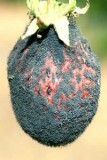 black rot
black rot 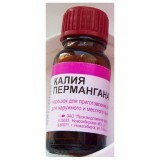 2 grams of potassium permanganate
2 grams of potassium permanganate Powdery mildew or spots on leaves
Powdery mildew is another fungal disease of strawberry. It can attack any of its parts( especially strongly - leaves) at any time from spring to autumn. This disease is characterized by a light gray bloom, from which the leaves very quickly coarsen and dry. If it appeared during the ripening of strawberries, then the berries can acquire a characteristic unpleasant odor. All affected berries need to be collected and burned, since they can not be used for food.
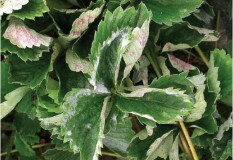
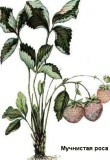
The best way to combat powdery mildew is prevention. In the early spring( long before flowering), as well as after harvesting bushes need to spray pasta Sulfarid. It must be dissolved in water in the proportion of 2 tablespoons without a slide on a bucket of water. Another option - a solution of potassium permanganate( 1.5 grams of powder per bucket of water).
If you need to treat plants after the buds start to appear, you need to use a solution of colloidal sulfur. One hundred gram of sulfur should be diluted in 10 liters of water. In this case, the water should be warm( about 25 degrees).The same solution is also suitable for post-harvest treatment.
 100 g of sulfur colloidal
100 g of sulfur colloidal 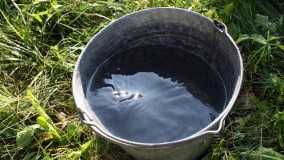 10 l of water
10 l of water Stain on strawberry leaves
This is another unpleasant problem that gardeners come across periodically. Such spots quite rapidly acquire a brown color and eventually the spoiled leaves fall off. In addition, such spots sometimes appear also on flowers, peduncles.
If you notice this problem, the bushes need to be sprayed with a solution of copper chlorite at a rate of 30-40 grams per bucket of water. Repeat this procedure three times:
- The first time - when the flowers appeared.
- Second time after ten days after the first procedure.
- Third time - after harvest.
 stains on leaves
stains on leaves 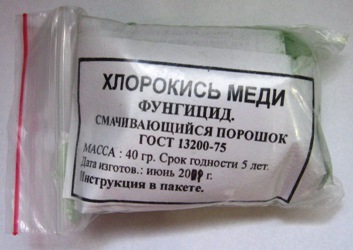 30-40 gr per bucket of water
30-40 gr per bucket of water
But if the disease struck a too large area, then after harvesting it is desirable to remove all the leaves.
Strawberry pests and methods for combating them
Strawberries are a tasty morsel for many types of pests. To keep the harvest intact and safe, it is important to know what to spray strawberries from pests. The fact is that against each pest - its kind of struggle and spraying, so you need to clearly distinguish them.
- Strawberry mite is the worst enemy of strawberry. He eats young leaves, which cause them to turn yellow quickly and change shape.
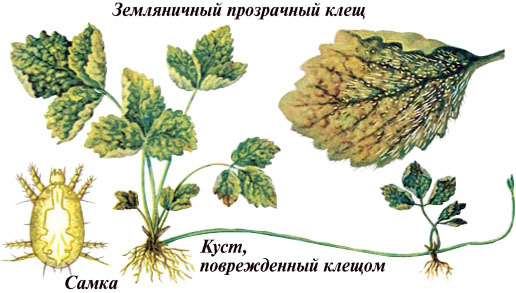
- Such a tick likes the wet weather very much. You can examine the tick on young antennas and in rosettes of fresh leaves. To prevent the appearance of the tick, the purchased seedlings must be lowered into warm water( 45 degrees) for 15 minutes. If there is a tick, it will immediately die.
- In the spring strawberries against strawberry mites can be sprayed with infusion of dandelions or decoction from the tomato leaves, which should be harvested from autumn.
- If you need a more radical solution to the problem, use carbofos. And do not forget after harvesting( in August) mow all the shrubs under the root so that the next year the problem does not return.
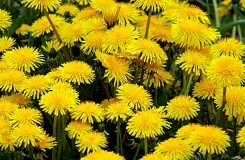 infusion of dandelions
infusion of dandelions 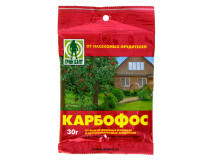 carbofos
carbofos
- In spring, a spider mite is often planted on a strawberry.
- He covers the strawberry leaves from below with his cobwebs and sucks out the vital juice from them. Among folk methods of fighting spider mite - spraying infusions of tobacco and wormwood.
- As far as chemicals are concerned, the drug Fitoverm is suitable. It must be sprinkled on the bushes after they have finished blossoming.
- Raspberry-strawberry weevil - the enemy of almost all garden berries.
- He eats young leaves and buds of flowers, and also puts eggs in buds. In people with a weevil struggle through spraying with decoctions of wormwood or a fresh chamois. It's the new chieftain that works without fail, but it's not easy to find it.
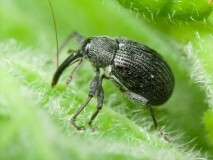 raspberry-strawberry weevil
raspberry-strawberry weevil 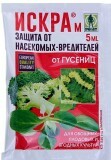 spark M
spark M
- If you decide to give preference to chemicals, then before the flowering you need to spray the drug Iskra-M, and after harvesting - Carbofos. Also in the autumn you need to thoroughly weed out the whole strawberry and burn the dried up greenery outside the plot. Ants also harm strawberries. However, they can be overcome without any chemistry. It is enough in 10 liters of water to dissolve a glass of sunflower oil and half a liter of table vinegar.
- To remove the dead wood is even easier. They really love everything wet, so you need to take birch brooms and soak them in water for four hours. After this, the brooms need to be placed in the aisles between the strawberries, and in the evening to collect them. For a day, all the slops will crawl onto the wet twigs.
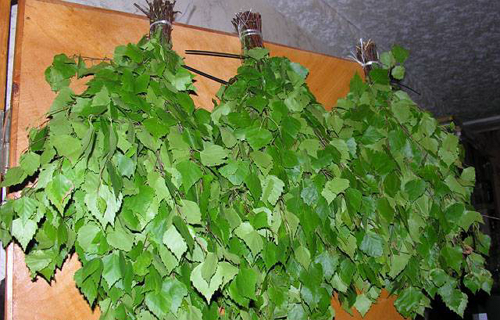
- He eats young leaves and buds of flowers, and also puts eggs in buds. In people with a weevil struggle through spraying with decoctions of wormwood or a fresh chamois. It's the new chieftain that works without fail, but it's not easy to find it.
Prophylactic spraying of
It is much easier to do preventive work than to treat injured bushes. To do this, you need to sprinkle strawberries in the spring.
- The purchased substances are best suited, because modern stores offer us the widest choice of such drugs. The strongest are the drugs Taurus and Caesar.
- If you are afraid of such substances, you may prefer biologics, for example, Fitovermu or Aktofit. However, remember, spraying strawberries with any of these substances at a temperature below 18 degrees does not make sense. Wait for warming before you start spraying.
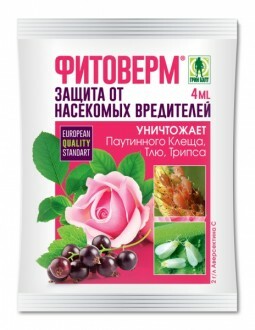
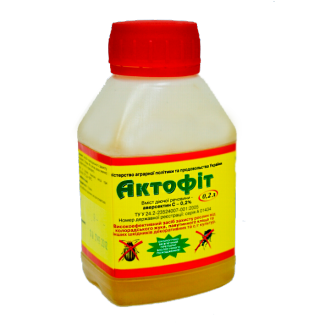
- If you want to avoid any medications at all, you can treat the strawberry bushes with hot water. To do this, heat the water to 60-65 degrees and use a watering can with a small strainer. There are two important rules:
- First, water should not cool down before time, it needs to be really hot.
- Secondly, water should fall on the leaves evenly. This method will not only save you from pests, but also accelerate the growth of strawberries.
- In addition, you can take note of the following recipe. There are quite a few ingredients in it, so you have to tinker, but the result will please you. All the ingredients must be mixed thoroughly and spray the mixture onto the strawberry.
 2 tbsp.l.liquid soap
2 tbsp.l.liquid soap 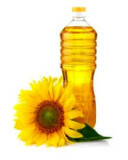 3 tbsp.l.burnt sunflower oil
3 tbsp.l.burnt sunflower oil 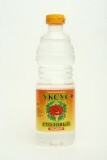 2 tbsp.l.of the bite
2 tbsp.l.of the bite
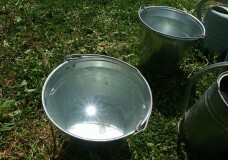 10 l.water
10 l.water 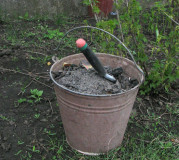 2 tbsp.l.ash
2 tbsp.l.ash
- 10 liters of warm( 30 degrees) water.
- 2 tbsp.spoons of any liquid soap.
- 3 tbsp.spoons of burned sunflower oil.
- 2 tbsp.spoons of ashes.
- 2 tbsp.spoonful of vinegar.
Spring processing of strawberries
The overall training plan is as follows:
- raking all mulch that has not rotted over the winter;
- work on the edges of beds;
- application of fertilizers( mineral or organic at your discretion);
- preventive spraying against pests;
- mulching.
Separately I would like to highlight the point about fertilizer. It is best to give preference to complex preparations. In a ten-liter bucket with water, you can add 1 tablespoon of ammonium sulfate and 2 cups of mullein or 1 tablespoon of nitroammofoski. Both these options will perfectly feed your strawberry bushes.
Related videos:
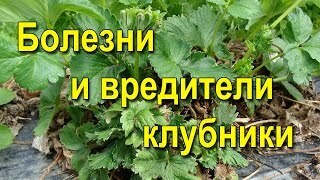 7:43
7:43 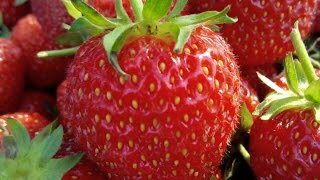 3:30
3:30 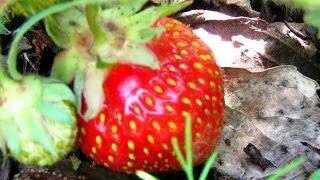 3:48
3:48 